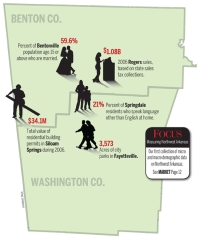Market Facts: Measuring Northwest Arkansas
by December 17, 2007 12:00 am 122 views

(To see an in-depth focus of the growth of northwest Arkansas, click here for an 11-page pdf.)
(For a look at northwest Arkansas’ top 20 chambers of commerce, click here.)
The city of Fayetteville landed as No. 8 on Forbes magazine’s April list of “Best Places for Business and Careers.” And the town was recently cited as one of the “Top Places to Retire” by U.S. News & World Report.
Many inhabitants argue the rankings should encompass the entire metropolitan statistical area, which includes Springdale, Rogers, Bentonville, parts of McDonald County in Missouri, many of the smaller towns adjacent and even Fort Smith.
We agree.
The Northwest Arkansas market is dynamic and extremely special: it’s a base to homegrown Fortune 500 companies with international impact, yet it’s small enough that you’re liable to bump into the CIO of one of those companies in the dairy aisle of your neighborhood market.
The editorial staff of the Northwest Arkansas Business Journal set out to explore some facts about our beloved market, and to compare them to some other markets that are either geographically close or frequently in competition for businesses.
On the following pages, you’ll see we made semi-scientific comparisons with multiple MSAs such as Dallas, Durham-Raleigh, N.C., and Spokane, Wash., based on each MSA’s size, diversity and similar growth patterns. We compared the number of hail storms, amount of available office space and the number of working doctors, among other things.
We picked Provo, Utah as a benchmark comparison for almost all of our following graphics because its MSA population is similar to ours (412,361 and 390,881, respectively), though its growth rate is nearly half (8.6 vs.19.9) and its median income was higher ($56,150 vs. $49,900).
After balancing many of those MSAs with the good fortune we’ve got here, we’ll steal a line from author L. Frank Baum: There’s no place like home.
